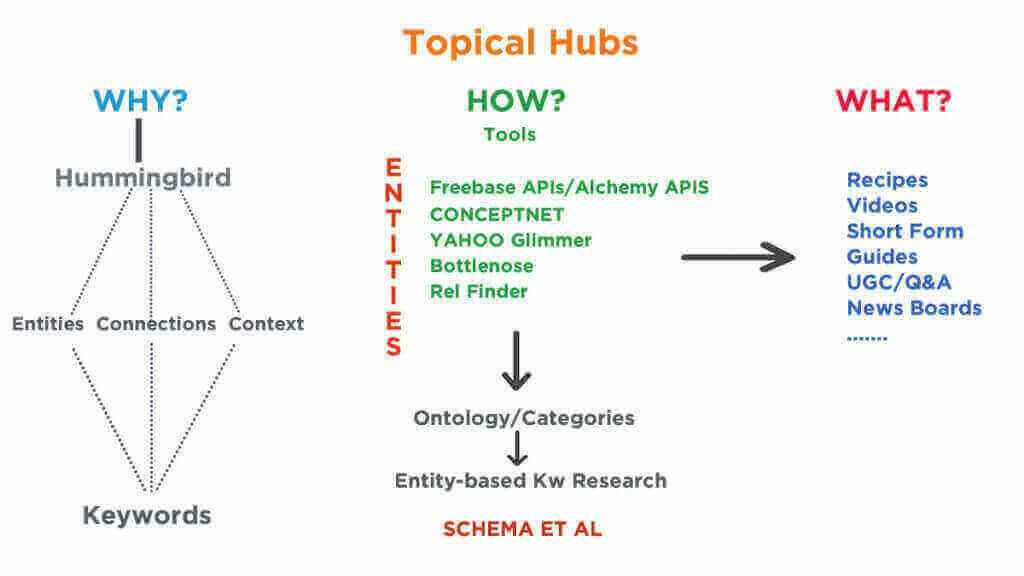What are content hubs?
We are talking about the importance of content hubs (also known as topical hubs) because they are a key element of Semantic SEO strategy following the introduction of Google’s Hummingbirds, that dramatically changed how we find results on the SERP.
Not so long ago, working on long-tail keywords was the new SEO trick and a true goldmine, but since the advent of Hummingbird, this is not working anymore.
Now, in order to optimize our website for semantic SEO and conversational queries, we have to think in entities, understanding the connection between the entities, and we have to be really sure about the context we are creating.
This new mindset will guide our keyword research.
- Start your research focusing on entities and not on keywords;
- The categories on our website are our content hubs;
- Create your content for the audience you’re serving.
Here is a blog post explaining how to create content hubs using AI.
Start focusing on entities
First of all, we need to focus on the concept related to the concept we want to explore. Let’s say we’re going to talk about books because we are a bookshop. What kind of books do we deal with? We can explore the history behind each book, their context, everything about the author and about book fairs all around the world.
We can focus on many different facts related to the concept of book.
Also, if we own a bookshop, this means we have a local site. We should also start thinking about entity searches related to our neighborhood. Once we have all these entities, we could start thinking about the ontology we want to use that we can extract from these entities, then deciding how to group them and create our categories for the website.
Our categories on the website can be seen as Content Hubs
On any given website, we usually have the homepage, then the category and product pages. How can we make our category pages rank? Let’s consider them as content hubs.
Think of your site as if it was a composition of contextually connected micro-sites. So each category page could be considered as a new site.
So now we can start optimizing our page, our content hub, with the keywords Google itself is extracting from the best SERPs of entities. We are creating a well-optimized page not only in terms of keywords but also in relation to entities.
When we talk about content hubs, we talk about the context, and the context is not just related to old classic SEO. Focusing on the context means giving value to the category page.
Create content for the audience you’re serving
The third step would be to do a good audience analysis, in order to understand that in our area we might have a certain demographic, so we can organize the content on the hub page focusing on that demographic. We can add some sort of values for our audience so that all our content could add some contextual and semantic value for Google too.
Now we can start focusing on the content we can create, in order for it to be contextually relevant both for our entity search and for our audience.
So, back to our bookshop, we can start adding a category for Recipes, extracting recipes from famous and not-so-famous books and tag them with schema.org/Recipe markup. We can record videos and mark them with schema.org/VideoObject. We can start writing guides, or submitting Q&A.
We could especially start to leverage events about the location we’re in, which is the neighborhood our bookshop is set.
By doing all these things we are creating something truly relevant about in a semantic way because we are really targeting our site to all of the entities related to our micro-topic. Having optimized it both on a keyword level and on a semantic search level we have created content which is relevant and responding both to our audience and Google.
